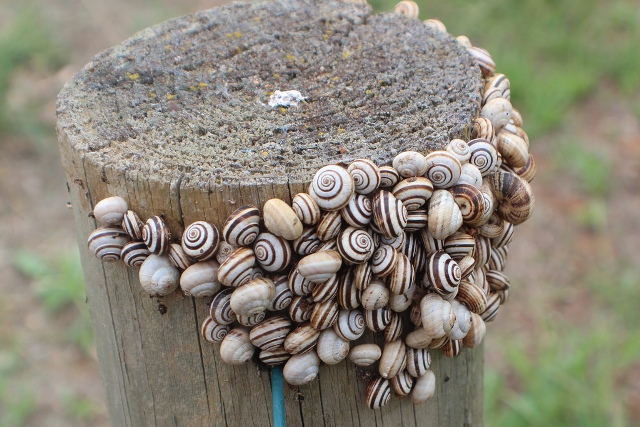Phylum Mollusca
Class Gastropoda
Informal group Pulmonata
Clade Stylommatophora
Common names: land snails and slugs
Overview
Stylommatophora are the largest group of land snails and slugs. They are characterised by two pairs of invaginable head tentacles, with the larger dorsal pair usually having an eye at the tip of each. Typically, a second pair of retractile tentacles function as chemoreceptors used to sense the substrate, food, and in some species, for mucus �trail following�. In shelled stylommatophorans (snails) a true operculum is absent, however in some species the posterior of the foot is modified to facilitate the same function (pseudo-operculum). The shell shape is usually dextral (coiling clockwise), but is sinistral (anticlockwise) in a few groups and is highly variable in shape, colour and pattern, with the majority cryptically coloured, but brightly patterned in many arboreal species. Around 16 families are slugs or semi-slugs, in which the shell has been drastically reduced or even lost entirely and their bodies are streamlined and worm-like. In these groups the lung cavity also is greatly reduced and accessory respiratory structures such as the mantle folds are well developed. Some slugs also only have a single pair of head tentacles. Stylommatophora vary significantly in size ranging from the giant African land snails (Achatinidae) having a shell height of up to 20 cm and the North American banana slug with a foot length of 25 cm when crawling, to the tiny European snail Punctum pygmaeum that has an adult shell diameter of around 1�1.5 mm.
Distribution and diversity
Stylommatophora is the largest group of terrestrial molluscs with over 20,000 described species widely distributed throughout the world with the greatest diversity in tropical and subtropical mesic forests. Many species, such as those from the snail family Helicidae and slug family Limacidae, have been introduced widely outside their natural ranges. Over 900 species in 274 genera from 56 families have been recorded in Australia, including a considerable number of exotics. Several families are Gondwanan in their distribution, with some, such as the Caryodidae and Cystopeltidae, endemic to Australia. One of the major families of land snails of the world, Camaenidae, is also the most widespread and diverse family in Australia with over 440 described species. Stylommatophora occur across the continent from tropical and temperate forests and woodlands to arid and semi-arid inland areas. Introduced species are also widespread, though are typically restricted to more damp, human-impacted habitats such as gardens, parks, pastures, on arable land, stream banks and roadsides and disturbed areas of native forest.
Life cycle
Most Stylommatophora are hermaphrodites that normally require fertilisation from another individual. Once a mate is located snails and slugs encircle each other and sperm is exchanged through their single genital pore. Many species can also reproduce via tiny �darts� of sperm which they throw in the direction of their mate's genitalia. A common occurrence is apophallation, when one or both of the mating pair removes the other's penis if they become entangled in their mate's genitalia which allows them to separate, subsequently remaining female for the rest of their life. Stylommatophoran eggs, often quite large in size, are typically laid individually or in clusters in the soil or leaf litter. However, ovoviviparous species are also known.
Feeding
Stylommatophora can be herbivorous, omnivorous and/or carnivorous, consuming a wide range of food sources. The majority are herbivores, consuming both above- and below-ground parts of plants, fungus, and decaying vegetable matter. They may also eat empty snail shells, sap, animal scats and carcasses, including dead con-specifics. Others species are predators of other slugs and snails and nematodes using slender, dagger-shaped teeth.
Ecology
Reflecting their diversity, Stylommatophora occur in a wide range of habitats and may be ground dwelling among rocks, moist leaf litter and soil, on or under plants or arboreal in trees. Like other terrestrial molluscs, stylommatophoran activity, behaviour and habitat preference is dependent on humidity. They are typically most active at dawn, dusk and during the night. During dry periods snails will seal themselves inside their shells and slugs will stay hidden in moist environments. Mucus �trail following� is used by some species to locate a mate or, in the case of mollusc-feeding predators, their prey. Slugs and snails are important components of many terrestrial ecosystems, as significant herbivores and as prey for large numbers of invertebrates and vertebrates. Many slugs and snails have distasteful mucus as a predator deterrent. Snails are also important in calcium cycling as they concentrate calcium from their food in their shells as calcium carbonate, which is then passed up the food chain as they are consumed by predators. Several species in the genus Helix (Helicidae) are cooked and consumed by humans (escargots). There are a significant number of slugs and snails that attack crops both above- and below-ground and are major agricultural pests. The giant African land snail (Achatina fulica) now occurs on most of the world�s continents where it consumes a wide range of plants. Quarantine officers at all major Australian ports regularly intercept individuals and there is a high probability that further outbreaks will be reported in tropical and subtropical Australia. The introduced common garden snail (Helix aspersa), has been in Australia for over 120 years and damages many varieties of fruit trees, vegetable crops, cereals and garden plants. Several species of Stylommatophora also act as the intermediate hosts of important nematode and fluke parasites of humans and domesticated animals. Worldwide, many hundreds of stylommatophoran are listed by the IUCN (International Union for Conservation of Nature), including several hundred as Extinct, and Critically Endangered. Many of these are endemic snails from the Pacific Islands, where the main causes of extinction are the destruction of the native forest and the introduction of predators for biological control. In Australia, many species of Caryodidae are very restricted in their distribution and may be considered endangered.


Bothriembryon sp. from Walpole, Western Australia
Image credit: Photographer: Mark Harvey
� Western Australian Museum












